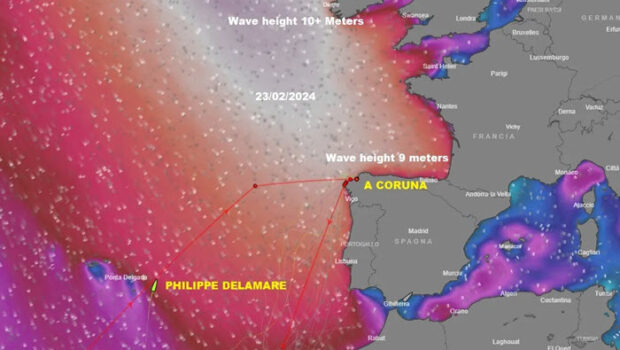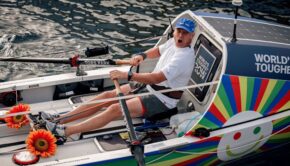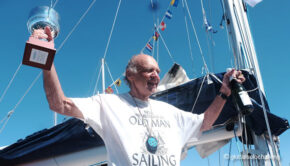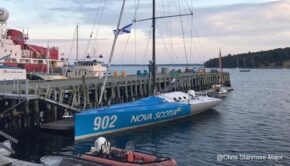Treacherous finish for Global Solo Challenge
Published on February 20th, 2024
by Marco Nannini, Global Solo Challenge
(February 20, 2024) – Philippe Delamare (FRA) is charging on his Actual 46 towards the Spanish finish in A Coruña as the leader in the 2023-24 Global Solo Challenge. His distance to finish is now approximately the same as a Fastnet, Sydney to Hobart or Middle Sea Race, just over 600 nautical miles.
These are the classic long distance races that are the highlight of many sailors’ racing seasons. For Delamare, it is just the final run home, after sailing more than 25,000. However, the oceans once more decided to prepare one last farewell storm for him. The weather forecast is absolutely unforgiving, and worrying.
Having arrived on two days ago in A Coruña, I mentioned the nice weather to the taxi driver and his immediate reaction was “this is a false spring breakout, just wait for the storm at the weekend, it will be one of the worst this winter.”
The weather charts seem to agree with the knowledgeable taxi driver as very strong north westerly winds will blow for days and pump up waves in excess of 10 meters in the north Atlantic and even A Coruña will be hit by 9 meter seas.
To give you an idea, this is when the authorities monitor the situation to decide whether to close the entire commercial port to shipping, and when the promenade behind the breakwater gets closed for fear that massive waves crashing over the concrete barrier will wash people in the water.
I was not surprised to hear from Philippe on satellite phone, inquiring about the navigable channel in between rocky shallows in front of A Coruña where these seas break into a white froth. There is only one approach marked on the charts.
Two lighthouses need to be aligned on the coast to pass between the coast and a rocky bank, until a further alignment is provided inside the bay of A Coruña to guide ships on a “safe” southerly approach. The approach is marked for huge commercial ships, but it is the only viable option in heavy weather, unless the port is altogether closed to traffic.
We don’t know what Philippe will decide to do, as he is currently sailing on his proverbial straight course towards the finish and we wonder whether he has decided to simply press on, or whether he’ll slow down to avoid some of the worst of these conditions.
He has an abundant margin on second placed Cole Brauer (USA) to take no risks at all and wait to pass behind the storm, just as many skippers had to do in waiting to round Cape Horn. To be fair, 9 to 10 meter waves is more than any skipper had to face in the Global Solo Challenge so far. Waves of 8 to 8.5 meters are what most had to deal with in the deep waters of the south Pacific. Big waves in shallow waters are far more dangerous.
Philippe may well be still monitoring the evolution of the weather before making a final decision as the forecast could develop favorably and he may find himself having slowed down for no reason. However, he will have to decide either way relatively soon as his ability to move in relation to a weather system is fairly limited. There is little point enduring 9 meter waves 100 miles to the finish line. In that case, he may as well press on to reach the safety of A Coruña as soon as possible.
Watching him having to deal with such nasty conditions brings back in me some of the tension and apprehension of last week, with two rescues in a matter of days. Dealing with Ronnie Simpson’s dismasting and evacuation and William MacBrien’s ordeal was tough.
As organizer, I was aware of these possible scenarios and dangers since announcing the event, and my university studies which included exams in statistics were telling me things had gone rather smooth up to that point. It is, however, difficult to suddenly deal with a situation as it evolves, with the uncertainty and apprehension and always wondering if all is being done to ensure the best possible outcome.
Dismasting or hitting something at sea is far more common than non-sailors imagine. I personally dismasted three times, never in life threatening situations, and even then it was never a pleasant experience, especially solo. In 2008, I ditched my mast overboard just like Ronnie whilst “only” 200 miles from south-west Ireland training solo for the 2009 OSTAR.
I’ve also hit or seen plenty of things at sea. I once sailed over a 20 meter full size tree complete with branches and roots, probably ripped by a spring flood in France and taken by a river to the sea. The boat came to a complete stop but we didn’t suffer any damage. I saw barrels, buoys, fridges, containers of any kind but I never had to deal with the consequence of an impact that caused an emergency.
Watching Philippe sail forward given the forecast makes me a little tense again, for fear of an accident caused by a breaking wave or stress to his rig. Whether Philippe decides to sail into A Coruña on his current route given the forecast is entirely his decision.
The boats are prepared to be capable of withstanding the conditions and therefore mine is an apprehension mostly derived from last week’s events which just reminded all of us how quickly things can change for everyone at sea. Ultimately, however, no one was hurt and this is also thanks to the preparation of skippers and boats.
An email from William MacBrien on Watatsumi explains the ordeal he had to deal with. Water initially was coming into his forward cabin which is separated from the rest of the boat by a watertight bulkhead. Despite attempts to empty the bow section, it was soon apparent that more water was being taken in than it could be pumped out.
During his fight with the water ingress, William began seeing water coming in the main section of the boat. Where from, he could not point out. This immediately changed the course of the situation as water could not effectively be contained in the forward watertight section.
Little by little, the boat kept filling and when William lost all power on board, he was left with over a foot of water in the main area and a bucket and knew it was a lost battle. He found refuge in one of the aft cabins behind a watertight door as the rising water crept into the engine compartment and slowly found its way in other compartments.
What this episode tells us is that the subdivision of the boat in separate watertight sections was crucial, but when two sections are affected, water pressure will increase on watertight closure which may not be perfectly watertight.
However, the watertight bulkheads gained William more than 48 critical hours of time since he noticed he was taking in water, until his rescue. Fortunately, enough to save his life. For comparison, a typical cruising boat with no watertight subdivisions and with such significant water ingress would sink in a matter of hours if not faster.
Dismastings, collisions, injury, medical problems and equipment failure are just some of the factors that can bring a participant’s adventure to an abrupt end. All of these risks can only be mitigated but never eliminated and skippers who approach this or similar events must be fully conscious that the safety regulations are not an empty bureaucratic exercise.
In the lead up to the event, we’ve had the unfortunate circumstance of having to refuse the entry of skippers not wanting to comply with the regulations. One in particular was adamant that we were just being apocalyptic and that he would have withdrawn his entry if forced to build watertight bulkheads. The skipper decided to retire rather than comply.
The complexity of participation in this type of event can be underestimated by enthusiastic new entries and some may think there is some leeway in the rules, or that they are mere indications but that they would be allowed to start even if in full compliance. That’s not the case and we encourage future entries to get in touch with the organizers well in advance to discuss their plans so that there are no surprises.
In this 2023-24 edition, we had a significant number of dropouts from initial registration to the final lineup to the start. In fairness, many dropouts were primarily due to lack of funding or running late with refits, but certainly a number were caused by underestimation of the safety framework and need to plan ahead to achieve compliance.
Needless to say, this edition will only keep the same commitment to a rigorous approach to safety and it will be very interesting to speak to all skippers once they finish to learn precious insights on what might be possible to improve things further, as often the devil is in the detail.
As A Coruña prepares to welcome Philippe Delamare, we wait to see what his strategy will be for his final approach. Adventure seems to take no breaks and whilst the south Pacific had us worry about storms despite the summer season, the north Atlantic winter storms should not be dismissed as a lesser danger.
Cole Brauer, Andrea Mura, Riccardo Tosetto and Francois Gouin continue on their ascent of the Atlantic. David Linger is still in Ushuaia to repair the boom of his boat. Alessandro Tosetti and Louis Robein are waving goodbye to New Zealand and taking the leap to their crossing to Cape Horn.
Just this morning, we have confirmed that Kevin Le Poidevin has announced he will retire from the Global Solo Challenge in Hobart. He has been affected by many factors that caused him to sail in last position since his delayed start.
As the time is running out to sail safely to Cape Horn before the end of summer, Kevin has very respectfully accepted the rule that prevents him from sailing further, and spontaneously announced his retirement. Safety comes before any dream.
Race details – Entry list – Start times – Tracking
Attrition List:
DNS: Peter Bourke – Class40, Imagine
DNS: Ivan Dimov – Endur37, Blue Ibis
DNS: Curt Morlock – IMOCA, 6 Lazy K
DNS: Volkan Kaan Yemlihaoğlu – Open 70, Black Betty
RTD: Juan Merediz – Class40, Sorolla
RTD: Dafydd Hughes – S&S 34, Bendigedig
RTD: Ari Känsäkoski – Class40, ZEROchallenge
RTD: Ronnie Simpson – Open 50, Shipyard Brewing
RTD: Édouard De Keyser – Solaire 34, SolarWind
RTD: Pavlin Nadvorni – Farr 45, Espresso Martini
RTD: William MacBrien – Class40, Phoenix
RTD: Kevin Le Poidevin – Open 40, Roaring Forty
The inaugural Global Solo Challenge 2023-24 seeks to be a budget-friendly solo, non-stop race around the world. Using a pursuit format for the 2023-24 race, 20 entrants from 34 to 70 feet have start times between August 26 to January 6 from A Coruña, Spain, with the first boat to return deemed the winner.
Source: GSC









 We’ll keep your information safe.
We’ll keep your information safe.